Archived Article Detail
By Thomas P. Moore
WHAT’S NEW IN THE MINERAL WORLD ARCHIVE – posted on 6/30/2006
Here is an installment of “what’s-new online” to take us through the midsummer. (midsummer, yes, indeed…in Tucson just now we’re enjoying a cool spell, with daytime highs of only about 100º, not due to get back to 105º for a couple-three days. Never mind: let’s look at minerals…).
Website News

Pinning down provenance information for brand-new mineral localities certainly can be tricky. When we find dealers contradicting each other we shouldn’t, of course, assume dishonesty on anyone’s part, since in most cases dealers, like their customers, only know what they’re told—commonly, what the last of a long chain of specimen handlers has told them—about the circumstances of new discoveries. In my Tucson Show report in the May-June 2006 issue (which U.S. subscribers, at least, have in hand by now), I briefly describe the new bluish to grayish green, part-gemmy elbaite crystals from India, saying that they came in September 2005 from “a pegmatite at Ladhak, in the Indian-occupied part of Kashmir,” and that Jordi Fabre had acquired “the whole lot…in all about 50 loose crystals.” That is the information I had from Jordi, who was, as far as I knew, the only dealer in Tucson who had, or who’d ever had, these elbaite crystals. But recently Jesse Fisher e-mailed to point out that Scott Werschky of the dealership Miner’s Lunchbox had offered a small lot of the same material at the 2004 Munich Show; the Indian elbaites, Jesse continued, had also appeared at last year’s Denver Show and on John Veevaert’s Trinity Minerals website. The locality given by Scott Werschky (i.e. that given to Scott by his own supplier) was, and is, “Amarnath, Himachal Pradesh, India.” Now, Himachal Pradesh is a province of India to the east of Kashmir, whereas Jordi’s “Ladhak” is the name of a large mountain range in Indian-occupied Kashmir; “Ladhak” thus is a very vaguely designated locality; but if it is correct, then “Amarnath, Himachal Pradesh” is incorrect; and conversely. Furthermore, did several discrete specimen lots emerge, beginning with the one Jesse says he saw at the 2004 Munich Show, followed by the one Scott Werschky says he saw at Munich in 2005; or has Jesse confused Munich 2004 with Munich 2005—recalling that Jordi’s source dated the (first?) discovery to September 2005? Pinning down information on brand-new discoveries certainly can be tricky (there’s an echo in my computer). Anyway, you can see about 10 loose Indian elbaite crystals, from 4 to 14.5 cm long, on www.minerslunchbox.com: they are attractive, sharp, lightly striated, semi-gemmy pale bluish green prisms with thin, bluer zones near the terminations. See also Jesse Fisher’s fine specimen, shown here: a lovely 10-cm elbaite crystal with, unlike all of the other Indian ones so far seen, a bit of matrix adhering.
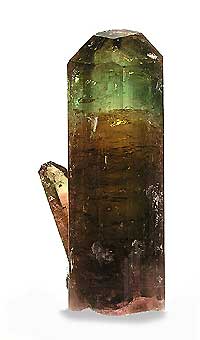
Rob Lavinsky’s Arkenstone website (www.irocks.com) has lately offered a handful of loose elbaite crystals too, these from “Coronel Murta,” Minas Gerais, Brazil. Reassuringly familiar-sounding, you think, but wait: Coronel Murta is a town in northern Minas Gerais, northwest of which lies a district of pegmatites covering thousands of intensively prospected acres, and fine “Coronel Murta” elbaite crystals could have come from, say, the Barra de Salinas pegmatites, the Genipapo (or Jenipapo) pegmatites, the Urubu pegmatite, the Terra Corrida or Baxao mine, the old Morro Redondo working…and so on. Actually Rob admits that he doesn’t know where, exactly, the new crystals came from, although he does know that a small pocket yielded a handful of them sometime in late February 2006, and the lustrous, gemmy crystals are fine indeed. They range to 25 cm long and are zoned in several colors, with a top zone, just under the termination, being a rich yellow in the majority of the cases.
At the 2006 Tucson Show, Jesse Fisher procured from Dudley Blauwet an excellent elbaite/albite/quartz cluster, 9 cm across, from the famous Stak Nala pegmatite in Pakistan, the first such discovery of any significance there in quite a few years; he also picked up from Dudley a tricolored elbaite crystal, 2 cm long, from a new Pakistani locality which may bear watching, given (by Dudley, for now) as Seydar, Ho Nala, near Chhappu, Skardu district, Northern Areas.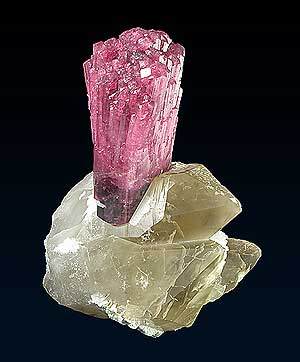 To conclude these tourmaline expostulations, let me first refer you to Dudley Blauwet’s cheerful and entertaining account, in May-June 2006, of his recent visit to the Luc Yen mining district in northern (the former North) Vietnam. There, he found, the excellent spinel and ruby corundum crystals which lately have been appearing on Western markets are being mined from a hillside exposure of white contact-metasomatized marble, this working being called the An Phu mine. Meanwhile, another digging, a few kilometers distant, in what is called the Minh Tien pegmatite, is producing the fine, large, pink, part-gemmy tourmaline crystals which debuted at the Tucson Show of 2005, attributed (wrongly, as it turns out) to the An Phu mine. As I mentioned in that report, the tourmalines of Minh Tien have been found to be liddicoatite for the most part, although some have cores of elbaite composition. Now for the good news: Dan Weinrich is soon to market on his website (www.danweinrich.com) a few superb liddicoatite specimens from a recent discovery at Minh Tien, these new crystals having a luscious, cranberry-red color which makes one think of the old Jonas mine, Brazil elbaite specimens of the early 1980’s. The crystals come in subparallel bundles of a “cathedral” aspect, with individual terminations (marked by low-angle trigonal faces) stopping at graduated heights. The bundles range from 2.5 to almost 12 cm; most have come out loose, but a few have small bits of adhering white pegmatitic material, and a very few are accompanied by chalky white feldspar crystals and/or glassy quartz crystals. In Dan’s best specimen, an 11.8-cm subparallel group of liddicoatite crystals rises vertically from a cluster of three pale-smoky quartz crystals, the specimen overall measuring 14.7 x 15.7 x 20.6 cm (see photo here).
To conclude these tourmaline expostulations, let me first refer you to Dudley Blauwet’s cheerful and entertaining account, in May-June 2006, of his recent visit to the Luc Yen mining district in northern (the former North) Vietnam. There, he found, the excellent spinel and ruby corundum crystals which lately have been appearing on Western markets are being mined from a hillside exposure of white contact-metasomatized marble, this working being called the An Phu mine. Meanwhile, another digging, a few kilometers distant, in what is called the Minh Tien pegmatite, is producing the fine, large, pink, part-gemmy tourmaline crystals which debuted at the Tucson Show of 2005, attributed (wrongly, as it turns out) to the An Phu mine. As I mentioned in that report, the tourmalines of Minh Tien have been found to be liddicoatite for the most part, although some have cores of elbaite composition. Now for the good news: Dan Weinrich is soon to market on his website (www.danweinrich.com) a few superb liddicoatite specimens from a recent discovery at Minh Tien, these new crystals having a luscious, cranberry-red color which makes one think of the old Jonas mine, Brazil elbaite specimens of the early 1980’s. The crystals come in subparallel bundles of a “cathedral” aspect, with individual terminations (marked by low-angle trigonal faces) stopping at graduated heights. The bundles range from 2.5 to almost 12 cm; most have come out loose, but a few have small bits of adhering white pegmatitic material, and a very few are accompanied by chalky white feldspar crystals and/or glassy quartz crystals. In Dan’s best specimen, an 11.8-cm subparallel group of liddicoatite crystals rises vertically from a cluster of three pale-smoky quartz crystals, the specimen overall measuring 14.7 x 15.7 x 20.6 cm (see photo here).
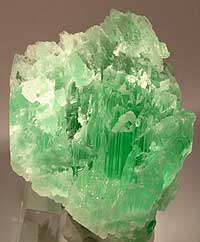
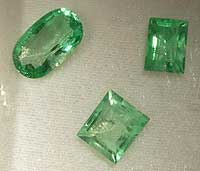 Dudley’s article mentions in passing the occurrence of “green microcline crystals” in the Minh Tien pegmatite. I therefore infer—repeat, merely infer—that Minh Tien is the source of some deeply etched gemmy crystals of microcline that Rob Lavinsky showed me in Tucson, of which Rob knew only that they had come from “Vietnam.” Crystal forms are barely discernible on these raggedy pieces of feldspar, but they reach cabinet-specimen size and are indeed transparent, below their frosted surfaces, in pale apple-green: I show here a photo of three faceted gems lately fashioned from the material, and one of a lump of gem rough.
Dudley’s article mentions in passing the occurrence of “green microcline crystals” in the Minh Tien pegmatite. I therefore infer—repeat, merely infer—that Minh Tien is the source of some deeply etched gemmy crystals of microcline that Rob Lavinsky showed me in Tucson, of which Rob knew only that they had come from “Vietnam.” Crystal forms are barely discernible on these raggedy pieces of feldspar, but they reach cabinet-specimen size and are indeed transparent, below their frosted surfaces, in pale apple-green: I show here a photo of three faceted gems lately fashioned from the material, and one of a lump of gem rough.
In his report on the 2006 Bologna, Italy show (appearing in our July-August issue), Renato Pagano briefly mentions recent new finds in the famous intrusive alkaline pegmatite of Mount Malosa, Zomba district, Malawi. John Veevaert, making his first visit to Bologna, was impressed enough by the new Mount Malosa material to scoop up an excellent selection of it, presently browse-able on his website (www.trinityminerals.com). In their 1994 Mineralogical Record article on the locality, Ole Petersen and Marcus Grossmann write of fine parisite-(Ce) crystals to 3.5 cm and arfvedsonite crystals to 8 cm, and also, of course, of superb aegirine, microcline and smoky quartz crystals—but Mount Malosa these days is both living up to these older billings and setting newer standards. The Trinity Minerals website shows very appealingly clean, crisp, wet-looking, medium-brown zircon crystals to 1.5 cm in groups with aegirine and chalky white feldspar crystals; velvety black arfvedsonite crystals to 5 cm, starkly offset against white microcline; doubly terminated, pagoda-shaped, chalky yellowish parisite-(Ce) crystals to more than 2 cm; and several mixed-species specimens upon which perch very sharp, gemmy, deep brown crystals of xenotime-(Y) to 6 mm. One intriguing thumbnail consists of a doubly terminated, jet-black aegirine prism 2.4 cm long partly jacketed by intergrown, translucent beige tetrahedral crystals of helvite individually to 5 mm—Petersen and Grossmann did not list helvite among the known Mount Malosa species in 1994; nor, for that matter, did they mention xenotime-(Y). ,-Malawi.jpg)
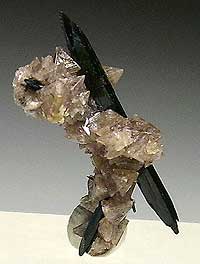
Another interesting item on the Trinity Minerals site is a handful of miniature and small cabinet-size specimens representing a new find of pretty fluorite from the Zogno mine, near the town of Bergamo, not far from Milan, northern Italy (another source denotes the locality as the Camissinone mine, Zogno). According to John Veevaert, this locality, now a “quarry-type setting,” has long been known to Italians; fluorite is the only collectible species occurring there, and most of the new specimens have been dug by up-and-coming dealer Emanuele Marini, a close associate of Dr. Federico Pezzotta. Lustrous, transparent, very deep purple, compound cubic crystals of fluorite (some with octahedral and dodecahedral modifications) perch on white limestone matrix; some rough-surfaced fluorite crystals reach 8 cm across, but the sharpest ones are about 2 cm. 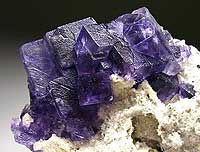
One of the most consistently interesting websites “out there” is that of David K. Joyce (www.davidkjoyceminerals.com), who specializes in native elements, sulfides and sulfosalts and in minerals from Canadian localities old and new, many of these latter being actively worked now for specimens by David (and his friends), in ways explained clearly by articles on the site. A recent addition is two pages of fine-looking thumbnail and miniature specimens of zircon won from carbonate vein-dike localities in Ontario and Quebec. Some of these sites are familiar classics, others are newly developed or redeveloped, and at least one is brand-new and still “classified.” David’s site is the place to look if you want an excellent zircon specimen from (among others) Anderson Lake, County Renfrew, Ontario; the Kipawa Alkaline Complex, Sheffield Lake, Quebec; a new roadcut occurrence (very promising!) near Bryson, Quebec; Kuehl Lake, Brudenell Township, Ontario; or the Smart mine, County Renfrew, Ontario.
Also this time, rather surprisingly, David Joyce is advertising about a dozen good specimens of siderite/quartz from Isère, France—from an old stash of these classic specimens just recently released. Sharp, simple rhombohedral crystals of chocolate-brown siderite to 2.5 cm on edge, some with partial films of “limonite” alteration, form loose clusters with thin, transparent-colorless prisms of quartz.
No less cherished an old classic than French siderite is the very rare zinc arsenate köttigite from its only known occurrence in presentable specimens: the Ojuela mine, Mapimí, Durango, Mexico, where most of the best köttigites were found in the 1970’s (see the “Mexico II” issue, Sept.-Oct. 2003). A group of these specimens which had been stored away, sure enough, about 30 years ago is being bathed now in the lucent daylight of the Lehigh Minerals website (www.LehighMinerals.com). The specimens are vuggy pieces of earthy brown “limonite” gossan, all trimmed to the same width (oddly) of 7 cm. On these matrix pieces are scattered, thinly or thickly, köttigite rosettes and sprays, to 5 mm, composed of acicular grayish greenish blue crystals; some of the sprays are altered on surfaces and are an unsightly yellow-brown, but others show quite fresh-looking, even a little lustrous in some cases, köttigite crystals. Silky grayish white gypsum prisms to a few centimeters accompany köttigite on some of these specimens. The Lehigh Minerals site offers also a few other good-oldtime Ojuela mine specimens of miniature to small cabinet size, including rosasite, conichalcite, calcite and (what else but) adamite.
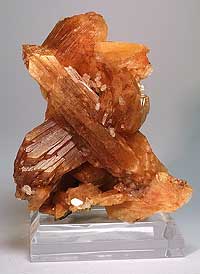
Beautiful crystal groups of stellerite—long since analytically verified, i.e. found not to be stilbite—from the Coonabarabran area of New South Wales, Australia, have been known for decades, but seldom indeed have specimens as fine as those to be seen now on the AA Rock Shop website (www.aarockshop.com) been held up for delectation (or, come to that, offered for sale). Collected on Easter weekend 2003, the specimens show translucent and lustrous, perfectly sharp, bright peach-orange “wheatsheaf” stellerite aggregates in loose groups, the individual wheatsheaves reaching more than 6 cm long, the groups reaching 8 cm across. According to Andrei V. Rykoff, proprietor of the dealership, the precise locality is Tambar Springs, in the Coonabarabran area of the Warrambungle Range, New South Wales.
The Italian dealership Minservice (wwwminservice.com) puts up a classy website which I have mentioned before, since several times it has featured attractive new things not seen anywhere else. Visit now, and you’ll find a luscious, fast-vanishing (or so I’d think) selection of thumbnail and miniature specimens of augelite from a “new find” in the Ortega mine, Ancash Department, Peru. No details concerning the find are provided (and I did not get an answer to my e-mail inquiry), but augelite specimens of any consequence have simply not been noted before from anywhere in Peru, and these are major examples of what is both a rare and attractive species—fully comparable, I’d say, to even the best of the augelites from the Rapid Creek/Big Fish phosphate region of the Yukon Territory, and of a similar color, at that. The Peruvian crystals are a lovely light green, transparent on thinnest edges but grading to cloudy and whitish in middle, thicker sections. They are very sharp, wedge-shaped, and lightly striated, with individuals reaching about 2 cm. Specimens offered by Minservice are either thumbnail clusters of augelite crystals without associated species, or augelite/quartz groups to 7 cm or so across, the augelite crystals being accompanied by transparent-colorless, thin quartz prisms, the whole resting on massive quartz/muscovite matrix. It would be very good news if this were the beginning of major supplies of specimens such as the teaser one on the website—shown also here. 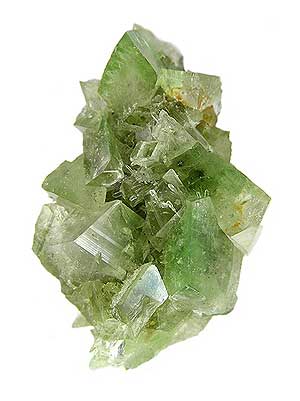
Another site which I’ve highlighted before in this space is that of Kevin Conroy Minerals (www.kcminerals.com), where many good and unusual things can (still) be found tucked away, awaiting attention from discriminating collectors. Kevin now has several pages of fine old worldwide classics which he is selling on consignment for an anonymous collector, and quite a few of these are excellent bargains. He also has things from someone’s fine former collection of thumbnails from Arizona, including snazzy malachite pseudomorphs after azurite from several old localities, and chrysocolla and other sorts of pseudocrystals from mines in the Arizona copper country. I was impressed, too, by about 20 small-miniature to small-cabinet specimens of brilliantly lustrous, midnight-black hematite of the “kidney ore” type: loose pieces with rolling reniform surfaces and no matrix. These are not from Cumbria, England, or even from Michigan or Wisconsin, but rather from the old lead-mining prospects of Taouz, Morocco, known best for world-class vanadinite and cerussite. And that reminds me: the German-language book by Steffen Jahn et al. called Marokko: Land der schönen Mineralien und Fossilien (2003), is a beautiful, masterful, encyclopedic production and (so far) the last word on Moroccan specimen mineralogy, hereby recommended even to non-German readers. In this book you will find pictures of Taouz hematite specimens just like the ones on Kevin Conroy’s website. You can order a copy of the book, at 89 Euros plus postage and handling, from the publisher, Bode Verlag, Haltern, Germany (geoagentur@aol.com).
All right, it is now time for CHINA—a red-hot category these days which this time, arbitrarily, I’ve saved for last. Begin with a few specimens of the hydrous hydrated Pb-Al phosphate plumbogummite from the Yangshuo mine, Guanxi Province. Seen on the website of Prague-based David Kalat Minerals, aka. Rockshop.cz (www.david-kalat.com), the specimens are matrixes 5 to 9 cm across coated solidly by blue-green botryoidal plumbogummite: they are only moderately attractive, but represent this extremely rare species very well. A few equally-good-to-better plumbogummites from the Yangshuo mine were offered last year on Rob Lavinsky’s Arkenstone website; otherwise the only comparable specimens worldwide are classic 19th-century ones (with pyromorphite crystals) from the Caldbeck Fells district, Cumbria, England.
In my 2006 Tucson Show report I mentioned how, in the unlikely setting of an outdoor tent at the Riverpark Inn hotel show, I came on a dealership offering about 50 excellent stibnite specimens from the “Nandan mine,” i.e. from some mine exploiting the Chashan antimony deposit, between the towns of Nandan and Hechi, Guangxi Province. These Romanian-style “hedgehog” aggregates of stibnite crystals, typically resting on gray-white matrix plates, make for very fine specimens, too often, unfortunately, melded in collectors’ minds with what are in fact the very different-looking stibnites of the Xikuangshan, Lushi and Wuning mines. From the dealership which goes, apparently, either by www.mineral-china.cn or by www.china-mineral.cn, I learned that the pieces I’d seen in Tucson are probably products of a single large pocket which, the site says, was discovered at Nandan sometime in 2005. The increasingly interesting and impressive China-Mineral (or Mineral-China) site, which I’ve mentioned here before, remains well stocked in Chinese material generally, and is now offering about 20 specimens of the new “Nandan” stibnite at what must, from a Western vantage, be called very low prices. The matrix pieces display individual, bright stibnite sprays to 7 cm deep.
Ah, but then there are the Chinese stibnite/calcite specimens of a really-truly new type which Brice and Christophe Gobin (www.mineralsweb.com) have lately scored, and of which they are showing big juicy pictures on their website (one is also shown here). According to the Gobins, the pocket produced about 150 specimens, and of these only about 25 came out without significant damage—no wonder, for the steely metallic stibnite prisms, many doubly terminated, are very thin, and reach 15 cm long. On, around and between the skewer-like crystals of stibnite rest clean, sharp, translucent gray-white scalenohedral calcite crystals to 1.5 cm. They populate the stibnite skewers and clusters of two or three skewers sometimes densely, sometimes sparsely; on some specimens there are also dustings of colorless cubic microcrystals of fluorite. As for the locality, well, the Gobins were given “Banpo mine, Dushan, Guizhou Province,” and this is not listed in the Smith-Smith-Liu-Ottens Chinese locality index in the special China Issue (Jan.-Feb. 2005). Perhaps by the time this is posted the Gobins, or someone, will have come up with more information—better yet, with more of these very nice specimens of stibnite/calcite. 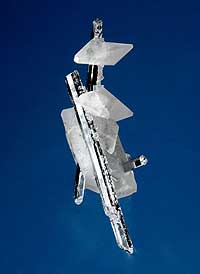
A final, very late newsflash from China concludes this report: Steve Behling informs me that Bryan Lees’ Collector’s Edge dealership (refer to steve@collectorsedge.com) has brought in a shipment of excellent acanthite/wire silver specimens from an as-yet unspecified mine in Shanxi Province: to quote Steve, “these specimens are unique, attractive, and may well be considered the finest combination pieces of silver/acanthite ever discovered.” The mine, “situated in remote, desolate terrain,” produces Pb, Zn, Ag and Mn ores in commercial quantities, and Collector’s Edge employees in China became aware of the silver-minerals occurrence late in 2005. The acanthite comes as crystals to a few millimeters across, predominantly of cubic habit, medium-lustrous and generally with solution-etched, slightly pitted surfaces; thin, very bright wires of silver rise from these surfaces, in some cases fully coating the acanthite crystals, in others forming discrete lustrous “nests.” Gemmy, brown-yellow sphalerite microcrystals occasionally are associated as well. There are also a few specimens showing thicker silver wires in twisted aggregates without acanthite, these much resembling silver specimens from Kongsberg, Norway. Pieces from the discovery may presently be viewed on the Collector’s Edge site via a new “access” portal at www.MinVision.com, which portal, by the way, can also lead you to the old-classics hunting ground of Ian Bruce’s Crystal Classics Fine Minerals; the “access” site is due for expansion soon, after which it will lead to yet other dealerships.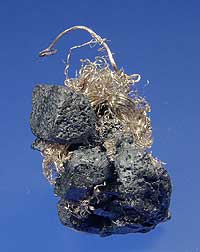
Mineralogical Record has New Printer
A notice to subscribers of the Mineralogical Record: Publisher Wendell Wilson informs me that, in the quest for the best possible printing quality for the magazine, we will be changing printers, from Cadmus Professional Services in Easton, Maryland, to Allen Press in Lawrence, Kansas. (Allen Press also prints Gems & Gemology.) One of the differences is that each issue of the magazine will now be mailed from Kansas rather than Maryland, and this will affect delivery times. Subscribers on the East Coast will probably receive their copies about a week later than they have come to expect, and subscribers on the West Coast should receive theirs about a week earlier than before.
Steve Smale’s Spectacular New Book
Prominent California collectors Steve and Clara Smale have recently published a gorgeous new book devoted simply to picturing many of the fabulous specimens in their extensive and very elite collection. The book, entitled The Smale Collection; Beauty in Natural Crystals, measures just under a foot square and depicts about 100 of their specimens in full-page photos by Steve himself and by Jeff Scovil. The text is minimal, giving only the species name, size and locality plus the history of ownership (which is often quite interesting). The book is beautifully produced by the husband-and-wife team of Gloria Staebler and Günther Neumeier, who also publish the Lapis-English series of books. Copies can be ordered from the Bookstore section elsewhere on this website, for the highly reasonable price of $50. Remember: books purchased through the Mineralogical Record website help support the magazine. 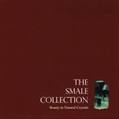
As I am finishing this report a “dry” lightning storm is lowering, crackling, over the ridge of the Santa Catalinas which I can see, in full march along the horizon, from my study’s window; and so, if you’ll pardon me, I’ll just step outside now, where the temperature has dropped to a very cool 85 F, to try to pick up that miracle of a wet-desert creosote scent that bespeaks rain, somewhere, somehow, in the surly slow-bake of a Tucson summer. May you remain very very cool where you live, and may you make it, come still-distant September, to the Denver show.
Postscript: a Flash of Gold
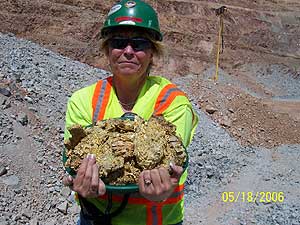 The foregoing report was first posted on June 9, but today, June 14, there is news out of the Round Mountain gold mine, Nye County, Nevada, which necessitates a postscript—indeed what deserves to be called a hot newsflash. Some background: mining of gold at the Round Mountain mine proceeded vigorously from ca. 1906 to the 1930’s, and again after 1975; annual production as of 2004 was 720,000 ounces of gold. The open-pit mine exploits a white, sericitized volcanic rock with generally no visible gold, the metal being extracted from the low-grade ore by cyanide leaching. But a narrow quartz-orthoclase-gold vein was discovered along one wall of the pit in the late 1980’s, and specimens showing leafy and crystalline gold were extracted. As the vein is only occasionally accessed, specimen gold from the Round Mountain mine may be expected to appear only sporadically—but some lots marketed in 2005 were greatly encouraging (see my 2005 Tucson Show report, plus a photograph of a luscious Round Mountain gold specimen measuring 6.8 cm, in the May-June 2005 issue). Now, the Mineralogical Record has learned that a few weeks ago a piece of ore weighing 55 pounds and consisting largely of native gold was dug by hand, in about two hours, in the Round Mountain mine—see the photo here—and that a geologist has estimated that over a million dollars’ worth of gold came out of the very high-grade ore zone in question within three days. To stare at the photo is to speculate that a fair number of excellent crystallized gold specimens might be fashioned from the 55-pound lump alone, and more still, presumably, from the rest of the material found. On that golden note, farewell again for the summer.
The foregoing report was first posted on June 9, but today, June 14, there is news out of the Round Mountain gold mine, Nye County, Nevada, which necessitates a postscript—indeed what deserves to be called a hot newsflash. Some background: mining of gold at the Round Mountain mine proceeded vigorously from ca. 1906 to the 1930’s, and again after 1975; annual production as of 2004 was 720,000 ounces of gold. The open-pit mine exploits a white, sericitized volcanic rock with generally no visible gold, the metal being extracted from the low-grade ore by cyanide leaching. But a narrow quartz-orthoclase-gold vein was discovered along one wall of the pit in the late 1980’s, and specimens showing leafy and crystalline gold were extracted. As the vein is only occasionally accessed, specimen gold from the Round Mountain mine may be expected to appear only sporadically—but some lots marketed in 2005 were greatly encouraging (see my 2005 Tucson Show report, plus a photograph of a luscious Round Mountain gold specimen measuring 6.8 cm, in the May-June 2005 issue). Now, the Mineralogical Record has learned that a few weeks ago a piece of ore weighing 55 pounds and consisting largely of native gold was dug by hand, in about two hours, in the Round Mountain mine—see the photo here—and that a geologist has estimated that over a million dollars’ worth of gold came out of the very high-grade ore zone in question within three days. To stare at the photo is to speculate that a fair number of excellent crystallized gold specimens might be fashioned from the 55-pound lump alone, and more still, presumably, from the rest of the material found. On that golden note, farewell again for the summer.
For questions about this column, please email Tom Moore.
